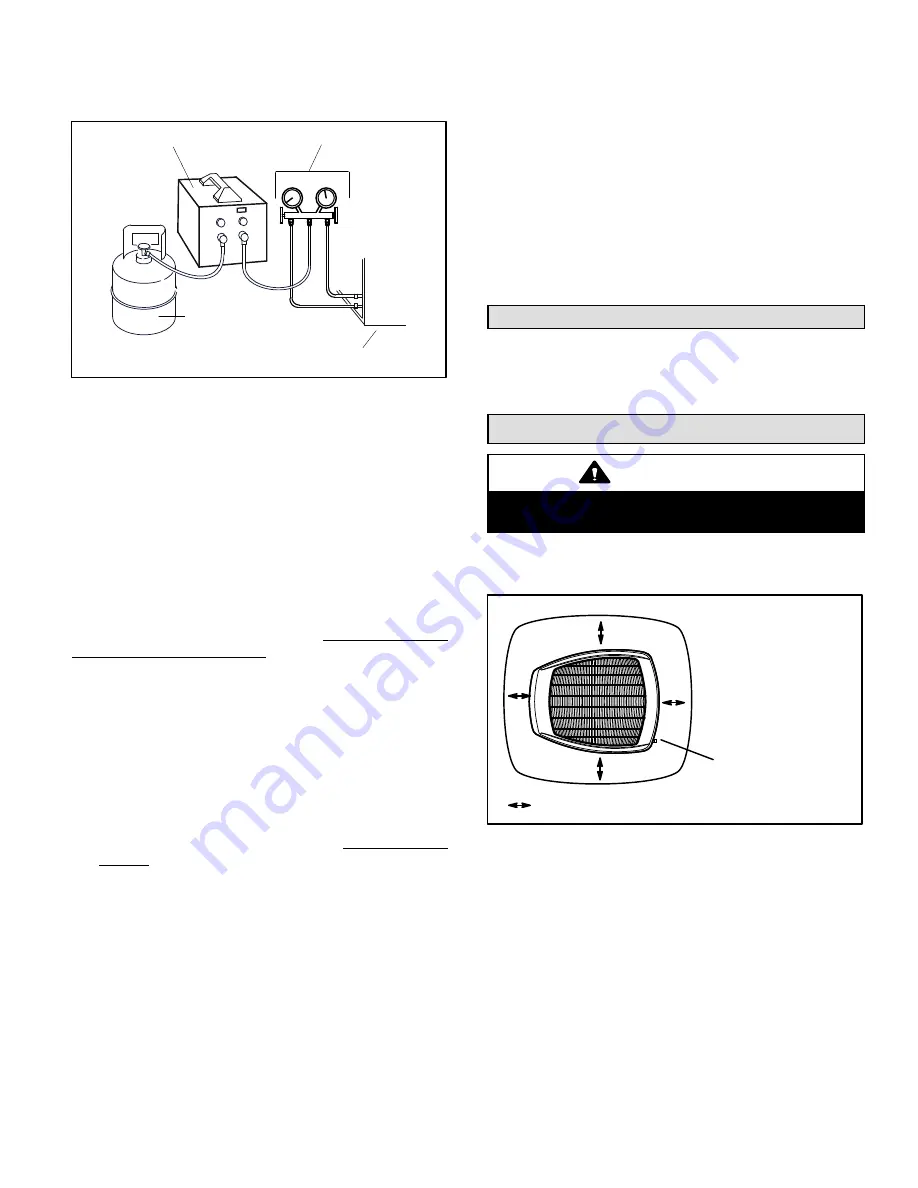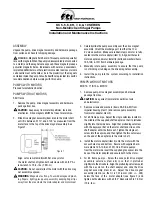
Page 5
XP19 SERIES
3. Remove all HCFC−22 refrigerant from the existing
system. Check gauges after shutdown to confirm that
the entire system is completely void of refrigerant.
MANIFOLD GAUGES
RECOVERY MACHINE
CLEAN RECOVERY
CYLINDER
OUTDOOR UNIT
Figure 7. Typical Refrigerant Recovery
(Method 1)
NOTE Use recovery machine instructions for specific
setup requirements.
METHOD 2:
Use this method if the existing outdoor unit is equipped
with manual shut−off valves, and plan on using new
HCFC−22
refrigerant to flush the system.
IMPORTANT
: Some system configurations may contain
higher than normal refrigerant charge due to either large
internal coil volumes, and/or long line sets. The following
conditions may cause the compressor to stop functioning:
The following devices could prevent full system charge
recovery into the outdoor unit:
S
Outdoor unit’s high or low−pressure switches (if
applicable) when tripped can cycled the compressor
OFF
.
S
Compressor can stop pumping due to tripped internal
pressure relief valve.
S
Compressor has internal vacuum protection that is
designed to unload the scrolls (compressor stops
pumping) when the pressure ratio meets a certain
value or when the suction pressure is as high as 20
psig. (Compressor suction pressures should never be
allowed to go into a vacuum. Prolonged operation at
low suction pressures will result in overheating of the
scrolls and permanent damage to the scroll tips, drive
bearings and internal seals).
Once the compressor can not pump down to a lower
pressure due to one of the above system conditions, shut
off the suction valve. Turn OFF the main power to unit and
use a recovery machine to recover any refrigerant left in
the indoor coil and line set.
Perform the following task:
1. Start the existing HCFC−22 system in the cooling
mode and close the liquid line valve.
2. Pump as much of the existing HCFC−22 refrigerant
with the compressor back into the outdoor unit until
you have reached the limitations of the outdoor
system. Turn the outdoor unit main power
OFF
and
use a recovery machine to remove the remaining
refrigerant in the system.
NOTE It may be necessary to bypass the low pressure
switches if equipped to ensure complete refrigerant
evacuation.
3. When the low side system pressures reach 0 psig,
close the suction line valve.
4. Check gauges after shutdown to confirm that the
valves are not allowing refrigerant to flow back into the
low side of the system.
Removing Existing Outdoor Unit6
Perform the following task at the existing outdoor unit:
S
Disconnect line set at the service valves.
S
Disconnect electrical service at the disconnect switch.
S
Remove old outdoor unit.
Positioning New Outdoor Unit7
CAUTION
In order to avoid injury, take proper precaution when
lifting heavy objects.
See
Unit Dimensions
on page 3 for sizing mounting slab,
platforms or supports. Refer to Figure 8 for mandatory
installation clearance requirements.
SEE NOTES BELOW THIS FIGURE FOR FURTHER DETAILS.
CONTROL PANEL
ACCESS LOCATION
Figure 8. Installation Clearances
NOTES:
S
Service clearance of 30 in. (762 mm) must be
maintained on one of the sides adjacent to the control
box.
S
Clearance to one of the other three sides must be 36
in. (914 mm)
.
S
Clearance to one of the remaining two sides may be
12 in. (305 mm) and the final side may be 6 in. (152
mm)
.
S
48 in. (1219 mm) clearance required on top of unit.
S
A clearance of 24 in. (610 mm) must be maintained
between two units.






































